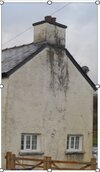- Joined
- 18 Jan 2022
- Messages
- 61
- Reaction score
- 1
- Country

Hi
Someone, I believe the previous tenant removed the chimney stack to make way for kitchen units. In the bedroom above the kitchen it appears he has installed an RSJ to hold the outer stack. It looks like he has capped off the chimney at the top and a chimney sweep said this was okay. What concerns me is the black area on the outer wall below the stack. Not sure if this is damp leaching through the stack. I cannot inspect the internal wall as a battened plasterboard wall was installed
Someone, I believe the previous tenant removed the chimney stack to make way for kitchen units. In the bedroom above the kitchen it appears he has installed an RSJ to hold the outer stack. It looks like he has capped off the chimney at the top and a chimney sweep said this was okay. What concerns me is the black area on the outer wall below the stack. Not sure if this is damp leaching through the stack. I cannot inspect the internal wall as a battened plasterboard wall was installed

